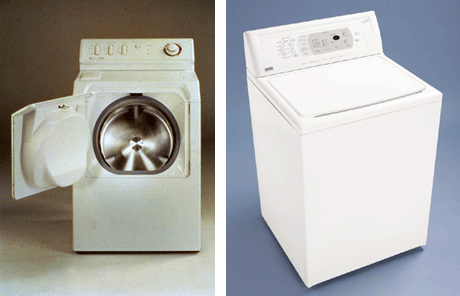Clothes washers and dryers account for 10 percent of the residential energy consumption, with most of the energy consumed for hot water used for washing.
- An estimated 85 percent to 90 percent of the energy is used for heating the water.
- Relatively, 10 percent to 15 percent of the energy is used by the clothes washer itself to operate the motor and controls.
A typical household does nearly 400 loads of laundry a year, and each load in a conventional washer uses 40 gallons of water. Therefore, any reduction in energy consumption for clothes washing application would involve reduction in hot water use.
Types of Clothes Washers
The basic principle for cleaning clothes has remained unchanged—wet the garment, agitate it to loosen the dirt from the cloth fibers, and then use more water to rinse the dirt off. What has changed over the millennia is the method of agitation? Pounding garments with stones was common for several thousand years, and along the way someone also figured out that using heated water got out a lot more dirt.
Clothes washers come in two types: Horizontal axis (h-axis) or front loading and Vertical axis (v-axis) or top loading (shown below).
Most clothes washers produced for the U.S. consumer are vertical axis (v-axis) washers with a central agitator. While there are variations, most v-axis washers suspend the clothes in a tub of water for washing and rinsing.
As an alternative, the horizontal axis (h-axis) washer tumbles the wash load repeatedly through a small pool of water at the bottom of the tub to produce the needed agitation. This tends to reduce the need for both hot and cold water.
The h-axis washer, popular in Europe, has a very limited market share in the United States at present. Yet, estimates have shown that a large quantity of energy and water could be saved through the replacement of conventional v-axis washers with the h-axis design.
H-axis washer
H-axis or tumble-action machines repeatedly lift and drop clothes, instead of moving clothes around a central axis. H-axis washers also use sensor technology to closely control the incoming water temperature. To reduce water consumption, they spray clothes with repeated high-pressure rinses to remove soap residues rather than soaking them in a full tub of rinse water.
Click the "play" button to see how an H-axis washing machine works. (Note: The animation has no audio.)
In a study conducted by Oak Ridge national Laboratory (ORNL) in 1998 for U.S. Department of Energy, it was found that, on average, the h-axis washer used 62.2 percent of the water used by the v-axis washer, and this yielded total water savings of 37.8 percent. Moreover, the average h-axis washer consumed 42.4 percent of the energy used by a typical v-axis washer in the study, resulting in energy savings of 57.6 percent.
Features of the h-axis washer include:
- Auto temperature. The machine will mix hot and cold water to a preset "warm" and "cold" so that the water is warm enough for the detergent to dissolve and optimally perform. During the winter in many parts of the country, cold tap water can be too cold to wash your clothes well.
- Water level settings. Some of the very high-end machines sense the amount of clothing and automatically adjust the water level, but all except the most basic machines offer at least four settings.
- Capacity. If you have a large household or athletes who produce an astounding amount of laundry each week, a larger capacity machine is a must. The front loaders generally hold more because they don't have the agitator. A definite minus for the front loaders, however, is the actual loading because you have to bend over to put in the clothes. To minimize this fact, the machines and their matching dryers are often displayed in stores on a raised platform.
